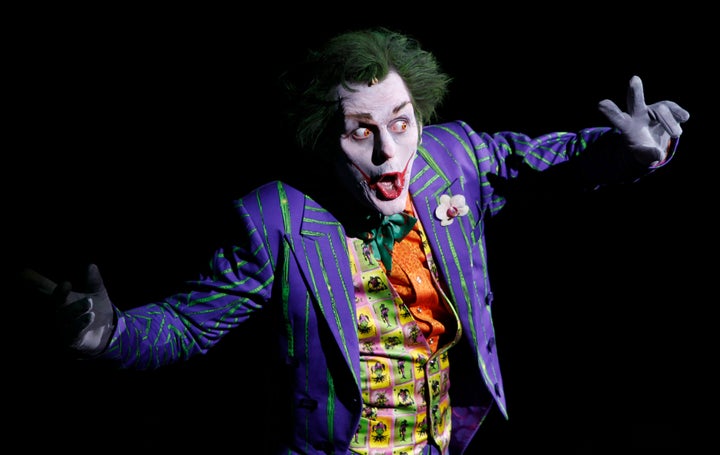
Batman may be a great crime fighter, but he's a lousy expert at mental health.
So says forensic psychiatrist Vasilis K. Pozios, M.D., a physician specializing in forensic and adult psychiatry who is also a big comics fan.
Although he says Batman deserves accolades for his detective work, the superhero would do well to go back to school to learn more about mental health as it relates to criminal behavior.
"As a mental health professional, Batman comes across as insensitive," Pozios told HuffPost Weird News. "He could definitely use more training in that area."
Or at least the folks who write the Batman comics or films could.
"There is still a misunderstanding to the portrayal of insanity in the Batman films and movies and what it means to be legally insane." Pozios said. "For instance, the Joker has been repeatedly hospitalized at the Elizabeth Arkham Asylum for the Criminally Insane, even though, in real life, he probably wouldn't qualify."
Pozios is hoping to do his part to help the Caped Crusader understand the villains that he's devoted his life to capturing.
On July 21, he and two other mental health experts, H. Eric Bender, M.D. and Praveen R. Kambam, M.D. -- who together form a trio called Broadcast Thought -- will team up with Mark E. Safarik, a retired FBI agent, to speak at the San Diego Comic-Con on a panel titled "Detecting Deviants in the Dark Night: Profiling Gotham City’s Serial Killers."
Although it's highly unlikely Batman will show up for the lecture (since, after all, he's not real) Pozios figures it may at least help fans of the character better understand real-life mental health issues through fictional characters.
This is nothing new for Pozios, Bender and Kambam, who spoke at last year's Con about the mental health issues facing Batman, the Hulk and Spider-Man.
"We hope that the audience gains a new appreciation of the Batman characters through our examination of them," Pozios said, adding that by using comic characters to deconstruct myths about serial killers, he and his colleagues aim to destigmatize mental health treatment and clear the connection -- or lack thereof -- between mental disorders and serial murder.
That said, Pozios concedes that doing a real profile of a fictional character is a bit of a challenge, since behavioral analysis is only as good as the data set or information available.
"Comic books contain fictional stories, and because of this, behaviors of characters may be different than what we would expect to see in the real world," Pozios said, adding that while the serial killers in Batman comics seem to predominantly be on a "mission," in the real world, it is much less common than serial murderers who kill for hedonistic reasons and reasons related to power or control.
"This discrepancy likely exists because in comic books, the mission is usually a plot device that drives the story," he explained.
In addition, Kambam says he and his partners in crime analysis have to take cultural issues into account.
"For example, in comic books, it’s culturally acceptable for people to don a cape, wear their underwear on the outside of their clothing and fight crime," Kambam said. "Fortunately, this is also culturally acceptable at Comic-Con."
Although all of the mental health experts are big comics fans, they are to be forgiven if the way the medium portrays mental health drives them crazy.
"One common misconception the public has about serial murder is that mental illness must play a major role in the killings," Pozios said. "This is because the public generally assumes that in order for someone to commit serial murder, particularly bizarre murder, they have to be 'crazy' or 'insane.' "
Pozios says that even though it is not normal for humans to commit serial murder, that doesn't mean that mental disorders, such as schizophrenia, bipolar disorder or major depressive disorder necessarily cause or contribute significantly to the development of serial murders either.
"In fact, particular patterns of behavior or personality traits -- what we call psychopathy -- are much more commonly seen in serial murderers," Pozios said.
Bender uses the example of the Joker, the most famous Batman villain, as a character who has incorrectly been called "psychotic" many times throughout Batman's 72-year history.
"Someone who is 'psychotic' is experiencing symptoms of psychosis, a mental disorder, which can include auditory hallucinations, such as hearing voices; visual hallucinations, where they see objects that are not truly there; or have delusional thoughts, despite evidence to show that such beliefs are incorrect -- such as believing that one's movements are being tracked by deep space satellites -- or disorganized behavior," Bender said. "In the vast majority of depictions, the Joker is not experiencing such symptoms; rather, the Joker has shown symptoms of psychopathy."
Bender says psychopathy is a personality construct and not a diagnosis of a mental disorder.
"Psychopathy reflects interpersonal characteristics and behavior that are often rooted in a lack of empathy," Bender said. "In the comics, television shows, and films, the Joker is much more akin to a psychopath and is not psychotic."

Although some snarky fans might suggest that the Joker just be put on Prozac, Bender says that's the sort of incorrect assumption he's trying to fight just as passionately as the Caped Crusader combats crime.
"Psychopaths are not prescribed medications to treat their psychopathic personality traits," Bender said. "They would be prescribed medication if they had a mental disorder, such as major depressive disorder or bipolar disorder, that causes clinically significant distress or impairment in functioning. In the vast majority off depictions, the Joker does not exhibit signs or symptoms of these or other mental disorders for which medication would be appropriate; therefore, we would not prescribe him any medication."
He's quick to add: "This is the type of message that we want audiences to understand. Just because a behavior is aberrant or considered 'crazy,' it does not mean that the behavior is the result of mental illness."
Another message that Kambam would like to get out to fans as well as writers of Batman films, movies or cartoons is a better understanding of the term "insanity."
"Batman villains, both serial murderers and non-serial murderers alike, are frequently referred to as 'insane' in the comics, but insanity is actually not a psychiatric or mental health term, but a legal concept," he said. "In the real world, only 1 percent of criminal cases plead not guilty by reason of insanity; only 20 percent of those 1 percent are successful."
Safarik, who worked for the Federal Bureau of Investigation’s elite Behavioral Analysis Unit -- the famed profiling unit showcased in the movie "Silence of the Lambs" and the television series "Criminal Minds" -- says Batman may do OK in the comics world, but a real-life version could definitely brush up on some forensic psychiatry if he wanted to bring his "A game" to the streets of Gotham.
"Many of Batman’s enemies have unique and highly demonstrative M.O.’s, and so it isn’t difficult for Batman to figure out who it is," Safarik said. "I think if faced with a homicide that evidenced much more subtle and complex behavioral clues, Batman would 'meet his Waterloo,' " Safarik said.
Bender, Pozios, Kambam and Safarik admit their analysis is as much for fun as it is to teach mental health basics to average Joes, but Bender also hopes their talk reaches Batman's publishing company, DC, which plans to restart 52 comic magazines at No. 1 in September in order to give them a modern rebooting.
"As forensic psychiatrists, we can add a lot of richness and realism to stories and characters," Bender said. "The added nuances that we offer help create more compelling angles to both story arcs and characters based on the true intersection of mental health and legal issues."
